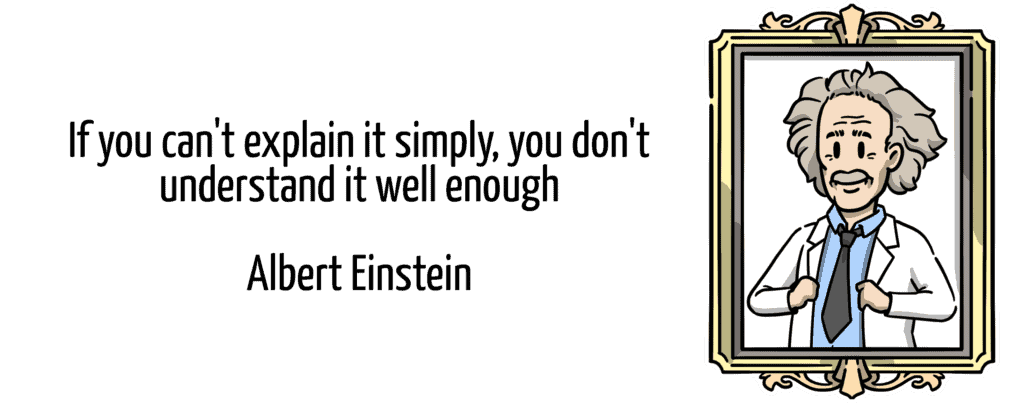Simplicity means leaving out everything unnecessary. Our explanatory experts will introduce you to the art of simplicity and teach you everyday ways to simplify. Welcome to the simpleshow special topic “simplicity”!
 Daily, a flood of data comes soaring at us: 105,000 words reach us every day, often in the form of text and e-mail. However, we don’t need numbers to convey the complexity of the modern world of communication. After all, most people are used to a life in which communication is constant, with numerous channels chatting away simultaneously. This complex landscape of information is not only accessible at any time, but also constantly updated through newsfeeds, messages, and notifications.
Daily, a flood of data comes soaring at us: 105,000 words reach us every day, often in the form of text and e-mail. However, we don’t need numbers to convey the complexity of the modern world of communication. After all, most people are used to a life in which communication is constant, with numerous channels chatting away simultaneously. This complex landscape of information is not only accessible at any time, but also constantly updated through newsfeeds, messages, and notifications.
We have learned to navigate the constant overload of content by pre-sorting at lightning speed. But, if we examine preferred communication styles, humans gravitate towards brevity. In fact, when it comes to the competition for our precious attention – simplicity wins! As adults, we have to unlearn the 3000-word essay method of our college days and aim to keep email in the 75-word range.
Say goodbye to filler words and modifiers, and say hello to straight to the point.
This applies to the presentation of products and services just as much as it does to training or informing employees. When a message needs to reach a target group, clarity and accessibility are the keys to success. However, for many, being simple is easier said than done.
In the flood of information, simplicity provides orientation
In the business world, communication is often the first thing that determines the success – of projects, teams, products, and entire companies. Where we are exposed to countless content and media competing for our attention in everyday life, clear formulations make all the difference. That idea applies to big product presentations, keynotes, emails, memos, and short messages.
Want to know how you can simplify your everyday business communication? Our interactive “email exercise” on simple language will show you just that. Simply click through it. Enjoy!
Why do we associate complex with expert?
Picture this: You’re sitting at lunch with colleagues having a relaxed conversation when a topic comes up that you’re the expert on. Suddenly, your tone of voice and choice of words change. You use more foreign words, make longer sentences, and express yourself in the passive voice rather than choosing active sentences. Why? Because you have learned that this is how experts speak. And your colleagues? Quite likely, their eyes have glazed over and they are ready for you to sum it all up already.

Mental imagination has the ability to transfer rock formations causated by continental drift in their local position.”
Or simply: Faith can move mountains.
In a survey of students at Stanford University, the majority said they changed terms in their scientific papers afterward in order to appear more intelligent thanks to complicated language. And the vicious circle of unnecessary complexity is complete. But does it have to be that way?
Learning from the big guys
 The greats of the tech industry show how it can be done better. A study that evaluated the speeches of Steve Jobs, Bill Gates, and Michael Dell came to the conclusion that each of the three strong speakers used wording below the usual university level. According to the study, Bill Gates spoke at the complexity level of an American tenth-grader, Dell at the level of a ninth-grader, and Jobs – who is generally considered to be one of the best speakers of the recent past – even chose language that corresponded to that of a fifth-grader. The result of the study: The simpler the language of a speaker, the more effective his speech was perceived by the audience.
The greats of the tech industry show how it can be done better. A study that evaluated the speeches of Steve Jobs, Bill Gates, and Michael Dell came to the conclusion that each of the three strong speakers used wording below the usual university level. According to the study, Bill Gates spoke at the complexity level of an American tenth-grader, Dell at the level of a ninth-grader, and Jobs – who is generally considered to be one of the best speakers of the recent past – even chose language that corresponded to that of a fifth-grader. The result of the study: The simpler the language of a speaker, the more effective his speech was perceived by the audience.
Images – the shortcut for the brain
 In addition to de-complicating language, our explainer experts swear by a tool of simplification that has been used since time immemorial to communicate directly, quickly, and simply: Images. Because nothing communicates complex relationships as efficiently as a well-chosen visualization.
In addition to de-complicating language, our explainer experts swear by a tool of simplification that has been used since time immemorial to communicate directly, quickly, and simply: Images. Because nothing communicates complex relationships as efficiently as a well-chosen visualization.
We grasp the content of images 60,000 times faster than text. And we retain what we have seen much better in our memory afterward. We remember about 80% of what we have grasped in pictorial form, but can only recall about 20% of the content later that we have only read.
Simplicity in business communication – what do the experts say?
 My experience as a concept designer has shown me how important images are for simplifying content. Therefore: Be aware of the power of images. Because they reinforce messages and anchor them in the minds of the target group. It’s not only the choice of the right image that matters but also the arrangement of images. During visualization, I ask myself the following questions, for example:
My experience as a concept designer has shown me how important images are for simplifying content. Therefore: Be aware of the power of images. Because they reinforce messages and anchor them in the minds of the target group. It’s not only the choice of the right image that matters but also the arrangement of images. During visualization, I ask myself the following questions, for example:
- Does the image convey the message in the best possible way?
- Are the references between the images correct?
- Are the proportions balanced?
- Could the image be misunderstood in other cultural contexts?
The rule of thumb for any simplification, including those with images, is: As simple as possible – as complex as necessary.
– Nadja Rußig, Team Lead Conception and Training Manager
 My advice for you concerns the flow of the text: Your text will appeal more to the reader if there is a thread running through it that guides the viewer. The most fluent reading is a text in which each sentence seems to follow from the previous one.
My advice for you concerns the flow of the text: Your text will appeal more to the reader if there is a thread running through it that guides the viewer. The most fluent reading is a text in which each sentence seems to follow from the previous one.
Words like “so”,”therefore”, “because”, “there”, “with it”, “for”, “because” and – if there is no other way – sometimes also “in order to” help. Because they can be used to knit transitions, references, and connections.
But also temporal links such as “now”, “then” or “now” help to explain processes or sequences.
I recommend that you proofread any important text at the end of the writing process, paying particular attention to causal links and transitions between sentences and paragraphs.
– Viktoria Koleva, Content Marketing Manager
 This is my conception tip: When writing, I avoid long sentences and filler words because nested subordinate clauses are difficult to understand. And also many adverbs (“extremely”, “very”, “unbelievably”…) are often superfluous. Once I’ve finished the script, I read my text aloud several times and make sure that the flow of language is correct. This way, bulky phrases are quickly noticed.
This is my conception tip: When writing, I avoid long sentences and filler words because nested subordinate clauses are difficult to understand. And also many adverbs (“extremely”, “very”, “unbelievably”…) are often superfluous. Once I’ve finished the script, I read my text aloud several times and make sure that the flow of language is correct. This way, bulky phrases are quickly noticed.
– Oliver Hillenbrand, Concept Writer
 Here’s my recommendation – and it doesn’t just help with simplification: Try to put yourself in your target group’s shoes!
Here’s my recommendation – and it doesn’t just help with simplification: Try to put yourself in your target group’s shoes!
Ask yourself a few simple questions: Who are your viewers? How old are they?
What is their position and what do they already know about the topic of your text?
If you have your target group well in mind and a clear feeling for them, think about the best way to reach your readers. This way, recipients will get exactly the information they need and your message is guaranteed to get through!
– Ineke Methner, Marketing Manager

The world is tending toward “VUCA” with increasing complexity in more and more areas. Companies that want to be successful under these circumstances can no longer avoid the topic of simplicity. Take a deeper dive into the exciting topic of simplification in a business context and download our informative whitepaper.
Would you rather take a practical approach to simplification in your company right away? Our explanation experts simplify your communication, hold workshops on the topic, and support you in becoming a simplification professional yourself. Contact us now!
